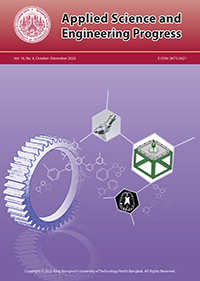Synthesis Gas Production with Gasification Technology from Municipal Solid Waste
Main Article Content
Abstract
This study aims to develop, test performance, and evaluate the environmental pollution of garbage fuel with gasification technology. Heat conduction from municipal solid waste (MSW) burning from the gasification process was studied to dispose of solid waste and produce energy for communities. There were four types of solid waste in the total amount of 5 kg (including 0.5 kg of charcoal and firewood, 1.5 kg of paper, 2.0 kg of leaf litter, 0.5 kg of plastic, and 0.5 kg of others) with 2 tested ranges of average humidity: 10–20% and 50–55%. It was found that all waste could be converted for gas production with different gas amounts. From the experiment, dried MSW with 10–15% moisture content produced synthesis gas compositions (mole percent) that were H2, CO2, N2, O2, and CH4 at 1.9–2.4, 1.8–3.2, 56.5–60.2, 3.4–4.6, and 1.2–1.6, respectively. When fuel gas composition at the equivalent ratio between 0.2–0.34 was obtained from the MSW burning test with 10–15% average humidity, MSW burning in various equivalent ratios resulted in different amounts of synthesis gas. In addition, the optimal amounts of CH4 and the heating value of the gas were in the equivalent ratio of 0.28, and the highest production efficiency of synthetic gas (ηg) was 33.46%.
Article Details
References
M. A. Alao, O. M. Popoolaa, and T. R. Ayodele, 2022, “Waste-to-energy nexus: An overview of technologies and implementation for sustainable development,” Cleaner Energy Systems, vol. 3, Dec. 2022, doi: 10.1016/j.cles.2022.100034.
W. Jangsawang, K. Laohalidanond, and S. Kerdsuwan, “Optimum equivalence ratio of biomass gasification process based on thermodynamic equilibrium model,” Energy Procedia, vol. 79, pp. 520–527, 2015.
U. Arena, “Process and technological aspects of municipal solid waste gasification. A review,” Waste Manage, vol. 32, no. 4, pp. 625–639, Apr. 2012, doi: 10.1016/j.wasman.2011.09.025.
A. Wattana, P. Watanawanyoo, and S. Nirukkanaporn, “A study on thermal efficiency of downdraft gasifier (swirl air type),” Journal of Current Science and Technology, vol. 10, no. 2, pp. 203– 215, 2020.
K. Jaojaruek, “Mathematical model to predict temperature profile and air–fuel equivalence ratio of a downdraft gasification process,” Energy Conversion and Management, vol. 83, pp. 223–231, Jul. 2014, doi: 10.1016/j.enconman. 2014.03.016.
M. A. Alao, O. M. Popoola, and T. R. Ayodele, “Waste-to-energy nexus: An overview of technologies and implementation for sustainable development,” Cleaner Energy Systems, vol. 3, Dec. 2022, doi: 10.1016/j.cles.2022.100034.
S. Khalilarya, A. Chitsaz, and P. Mojaver, “Optimization of a combined heat and power system based gasification of municipal solid waste of Urmia University student dormitories via ANOVA and taguchi approaches,” International Journal of Hydrogen Energy, vol. 46, no. 2, pp. 1815–1827, Jan. 2021, doi: 10.1016/j.ijhydene.2020.10.020.
T. Kohl, T. Laukkanen, M. Tuomaala, T. Niskanen, S. Siitonen, M. P. Järvinen, and P. Ahtila, “Comparison of energy efficiency assessment methods: Case bio-SNG process,” Energy, vol. 74, pp. 88–98, Sep. 2014, doi: 10.1016/j.energy. 2014.03.107.
A. Molino and G. Braccio, “Synthetic natural gas SNG production from biomass gasification – thermodynamics and processing aspects,” Fuel, vol. 139, pp. 425–429, Jan. 2015, doi: 10.1016/ j.fuel. 2014.09.005.
P. M. Lv, Z. H. Xiong, J. Chang, C. Z. Wu, Y. Chen, and J. X. Zhu, “An experimental study on biomass air–steam gasification in a fluidized bed,” Bioresource Technology, vol. 95, no. 1, pp. 95–101, Mar. 2004, doi: 10.1016/j.biortech. 2004.02.003.
A. Moro, B. F. Baffoe, M. Dalaba, and A. Oduro, “Fuel consumption for various dishes for a woodfueled and charcoal fueled improved stoves used in rural Northern Ghana,” International Journal of Environmental Sciences & Natural Resources, vol. 25, no. 1, pp. 42–53, Jun. 2020.
P. M. Lv, Z. H. Xiong, J. Chang, C. Z. Wu, Y. Chen, and J. X. Zhu, “An experimental study on biomass air–steam gasification in a fluidized bed,” Bioresource Technology, vol. 95, pp. 95– 101, Mar. 2004.
W. Arjharn, T. Hinsui, P. Liplap, and G. S. V. Raghavan, “Evaluation of energy production from different biomass feedstock using a pilot scale downdraft gasifier,” Biobase Materials and Bioenergy, vol. 6, pp. 1–11, 2012.
J. D. Martínez, K. Mahkamov, R. V. Andrade, and E. E. S. Lorab, “Syngas production in downdraft biomass gasifiers and its application using internal combustion engine,” Renewable Energy, vol. 38, no. 1, pp. 1–9, Feb. 2012, doi: 10.1016/j. renene.2011.07.035.
Q. Song, H. Zhao, J. Jia, L. Yang, W. Lv, J. Bao, X. Shu, Q. Gu, and P. Zhanga, “Pyrolysis of municipal solid waste with iron-based additives: A study on the kinetic, product distribution and catalytic mechanisms,” Journal of Cleaner Production, vol. 258, Jun. 2020, doi: 10.1016/ j.jclepro.2020.120682.
D.-J. Lee, “Gasification of municipal solid waste (MSW) as cleaner final disposal route: A mini-review,” Boresource Technology, vol. 344, Jan. 2022, doi: 10.1016/j.biortech.2021.126217.


